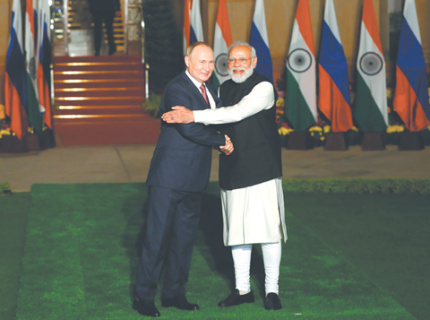Moscow is jealous, but not much
Washington has recently been exerting the strongest pressure on Delhi, seeking to abandon any cooperation with Moscow, especially military-technical. And it seems to give certain results. For example, India refuses new purchases of Mi-17 and Ka-31 helicopters.
In fact, there is nothing fundamentally new in this plot. There is quite a common competition – geopolitical and economic.
AMERICAN WEAPONS IN INDIA
The first deliveries of American weapons to India took place almost immediately after the country gained independence. In the 1950s and the first half of the 1960s, India acquired 200 M4 Sherman tanks in the United States, about 150 light aircraft and helicopters. After that, military-technical cooperation between the two countries was interrupted until the end of the Cold War. True, in the 1970s, India received fifty Mk 44 anti-submarine torpedoes, but the actual supplier was the United Kingdom.
In the early 1990s, more than 300 UAB "Peiway" were delivered from the USA to India. Then, in the early 2000s, purchases of shipboard LM-2500 gas turbine engines for the aircraft carrier Vikrant and frigates of the Nilgiri and Shivalik types began (however, in fact these turbines were supplied from Italy), as well as the TRQ-17 artillery reconnaissance radar. In addition, India has bought six UH-3H helicopters. The largest acquisition of this period was an amphibious helicopter-carrying dock ship of the Austin type (in India it was named "Jalashva"). However, for the huge Indian Armed Forces, such import volumes could be considered extremely insignificant.
India began truly large-scale purchases of American weapons in the 2010s. In the USA, 24 transport aircraft were purchased (11 heavy C-17A "Globemaster" and 13 medium C-130J-30 "Hercules"), 12 anti-submarine aircraft P-8A "Poseidon" and at least 32 Mk 54 torpedoes for them. 15 CH-47F Chinook heavy transport helicopters and 22 AN-64E combat helicopters (six more will be purchased, partially manufactured in India itself). Deliveries of MN-60R Sea Hawk anti-submarine helicopters are beginning (24 in total will be delivered).
Up to 250 FIM-92 Stinger missiles (as air–to-air missiles) and up to 1,350 AGM-114 Hellfire ATGM were purchased as Apache weapons. Over 500 UAB SVU-105s have been purchased for the Indian Air Force aircraft. More than 50 Harpoon missile defense systems were purchased (for equipping Poseidons, as well as Anglo-French Jaguar attack aircraft and German pr. 209/1500 PL).
Indian Tejas fighter-bombers are equipped with American F404 and F414 turbojet engines, and NTT-40 training aircraft are equipped with TRE–731 engines. American AIM–120D AMRAAM air-to-air missiles will be delivered to India as missiles for the Norwegian-made NASAMS air defense system.
Licensed production of American 155-mm M777 howitzers is underway in India (approximately 30 were produced, there will be 145 in total), guided Excalibur shells will be supplied to them.
In the fall of 2020, India and the United States signed the BECA agreement (Basic Exchange and Cooperation Agreement for Geo-Spatial Cooperation), which provides for the exchange of advanced military technologies and geospatial information between the two countries.
The agreement will allow India to get real-time access to accurate data and topographic images from American satellite systems. According to this agreement, the countries will be able to exchange topographic information, marine, air navigation and other maps.
This will help India to strike military targets in the region with high accuracy. India will also be able to monitor the movements of Chinese warships in the Indian Ocean and use US global maps to effectively combat cruise and ballistic missiles.
This was the fifth significant defense agreement that the United States concluded with India. Washington and Delhi have previously signed an agreement on the protection of military information (2002), a memorandum on logistics exchange (2016), an agreement on the compatibility of communications and security (2018) and an annex on industrial safety (2019).
RUSSIAN WEAPONS IN INDIA
To list the weapons and equipment purchased by India from the USSR and Russia for the entire period of cooperation, an article would be needed at least for a newspaper spread. Therefore, let's focus on the programs being implemented now.
One of the most important joint projects is the production of the PJ-10 Brahmos cruise missile, created on the basis of the Russian Yakhont missile.
The total output of Brahmos in India will exceed one thousand units. These missiles are created as universal carriers (ground-based launchers on an automobile chassis, Su-30 fighter-bombers, submarines and surface ships) and for targets to be hit (ground and surface). They are considered as the main missile system of the Indian Armed Forces as a whole.
Another important project is the licensed production in India of one of the Brahmos carriers – the Su-30MKI fighter-bomber.
The total volume of this production should reach 272 aircraft, at the moment the implementation of the program is close to completion. In addition, at least 12 additional Su-30MKI will be produced to compensate, firstly, for losses in disasters, and secondly, for the general shortage of modern combat aircraft in the Indian Air Force. India acquires a significant number (more than 700) of spare AL-31FP engines for Su-30MKI aircraft.
Russia is upgrading all previously delivered Indian MiG-29 fighters to the MiG-29UPG level (similar to the Russian version of the MiG-29SMT). Currently, more than 50 cars have undergone this modernization.
In addition, apparently, 21 MiG-29s will be purchased from the presence of the Russian Armed Forces, also with an upgrade to the MiG-29UPG level. This will at least compensate for the losses in disasters, and also, as in the case of the Su-30, will replenish the combat strength of the Indian Air Force. In addition, at least 1,000 R–27, R-77, and R-73 air-to-air missiles will be purchased (approximately 100 missiles of each of these types have been delivered now).
Licensed production of multi-purpose Ka-226 helicopters may be launched in India, it is planned to produce 200 machines of this type. But this contract has not been signed definitively yet.
The acquisition of Russian T-90 tanks (a combination of direct purchases and licensed production) is extremely important for the Indian ground forces. Under the first contract, 248 T-90 were delivered directly from Russia, another 409 were assembled in India. Currently, a contract is being implemented for the assembly of another 536 tanks, then another 464 vehicles will be produced in India. The total number of T-90 in the Indian army should be 1,657.
For these tanks and for the previously released T-72, 9M119 "Svir" anti-tank guided missiles launched through a tank cannon are manufactured in India under license. The production of the ATGM "Competition" in India is also continuing. In addition, 250 portable ATGMs "Kornet" were purchased (and at least 3 thousand ATGM to them).
Licensed production of the BMP-2 in India continues. To date, about 2.7 thousand of them have been produced, including auxiliary vehicles (self-propelled ATGMs, self-propelled mortars, KSM, medical and engineering vehicles). And at least 150 more of these IFVs will be produced.
India purchased 250 YaMZ-238 diesel engines for MPV armored vehicles produced in India (based on South African "Casspir").
In the near future, Russia will supply India with five regiments (apparently, two divisions each) of the S-400 air defense system, which will qualitatively improve the state of India's extremely archaic ground air defense at the moment. By now, the first two divisions have been delivered (that is, apparently, one regiment).
A contract has been signed for the supply of an additional four Talvar-type frigates to India (six such frigates were previously built in Russia for India). Two of them were previously intended for the Russian Navy, but they cannot be completed due to Ukraine's refusal to supply gas turbine engines for them. India was going to buy these engines in Ukraine separately, but the fate of this deal is now unclear.
Two more frigates of this type will be built directly in India. For these, as well as for other types of ships previously built and currently under construction in India, Russia will continue to supply artillery and other naval weapons and equipment. Of course, the Talvars' armament will include the Brahmos naval-based missiles.
It is almost certain that India will lease the second nuclear submarine ave. 971 from the Russian Navy instead of the "Seal" returned last year.
COMPETITION IN TODAY'S CONDITIONS
Military-technical cooperation between Russia and India will continue, if only because a number of projects implemented within its framework (T-90, Su-30MKI, Brahmos) are no alternative for India and constitute the "bearing supports" of the technical equipment of its armed forces. Delhi understands this.
As Indian officials openly admitted, India's acquisition of the S-400 air defense system was not only military, but also political in nature. It was designed to "balance" India's massive purchases of American equipment.
Thus, the competition between Moscow and Washington in the Indian market has been going on for a long time. Moreover, in addition to pure commerce, there is also a very strong political component in it. Now, for obvious reasons, it has become extremely acute.
A number of circumstances work against Russia in this case. Firstly, this is a very strong political, economic and propaganda pressure from Washington. Secondly, it is the desire of Delhi to significantly increase the share of equipment of its own production in the armed forces of the domestic Armed Forces. Thirdly, it is not too rapid development of the Russian special military operation in Ukraine, which gives rise to doubts and hesitations among Moscow's potential allies.
On the other hand, Delhi's desire to produce weapons at its own enterprises also works against Washington. In addition, the course of the special operation in Ukraine did not strengthen the reputation of NATO at all.
The alliance is so openly and cynically demonstrating a desire to fight against Russia to the last Ukrainian that potential US allies cannot help but draw parallels with themselves. In particular, India may well imagine a situation where the United States will fight against China to the last Indian.
Finally, Washington's too harsh pressure is starting to have the opposite effect. At least, in relation to such powerful and ambitious countries as India.
Russia's share in the Indian arms market will almost inevitably decline due to competition with other countries (this is not only the United States, but also Israel, France, the Republic of Korea, etc.) and with the military-industrial complex of India itself. In addition, in the near future, the Russian military-industrial complex will largely be busy replenishing the losses of its own armed forces. Nevertheless, as mentioned above, Delhi is too closely connected with Moscow in the military-technical sphere, and it is not possible to change this situation in the foreseeable future.
RED LINES AND HYPOCRISY WITHOUT BORDERS
As for Washington's pressure on Delhi, one point should be noted. More recently, when Moscow demanded an official refusal to accept Ukraine and Georgia into NATO, Washington and Brussels explained that nowadays no one has the right to dictate to any country with whom to be friends and which alliances to join.
It turns out that this does not apply to everyone. But the West allows itself to draw various "red lines" exclusively to itself. The hypocrisy of the West is becoming simply outrageous, but, apparently, they sincerely do not understand this. And they seriously believe that the West can certainly do what others cannot in any case. And that the rest of the world is obliged to take this state of affairs for granted.
In particular, since India is not bending as much as the United States would like, Washington suddenly noticed that "serious human rights violations" are taking place in this country! As the unforgettable Viktor Stepanovich Chernomyrdin said, "this has never happened, and here it is again."
Alexander Khramchikhin
Alexander Anatolyevich Khramchikhin is an independent military expert.


